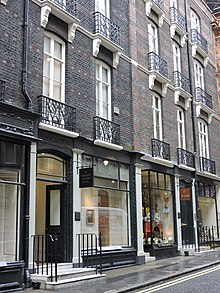
Mayfair is an area in London, England and is located in the City of Westminster. It is in Central London and part of the West End. It is between Oxford Street, Regent Street, Piccadilly and Park Lane and one of the most expensive districts in the world.

Twickenham is a suburban district in London, England. It is situated on the River Thames 9.9 miles (15.9 km) southwest of Charing Cross. Historically part of Middlesex, it has formed part of the London Borough of Richmond upon Thames since 1965, and the borough council's administrative headquarters are located in the area.

Sir James Pennethorne was a British architect and planner, particularly associated with buildings and parks in central London.

St James's is a central district in the City of Westminster, London, forming part of the West End. The area was once part of the northwestern gardens and parks of St. James's Palace. During the Restoration in the 17th century, the area was developed as a residential location for the British aristocracy, and around the 19th century was the focus of the development of their gentlemen's clubs. Once part of the parish of St Martin in the Fields, much of it formed the parish of St James from 1685 to 1922. Since the Second World War the area has transitioned from residential to commercial use.

Jermyn Street is a one-way street in the St James's area of the City of Westminster in London, England. It is to the south of, parallel, and adjacent to Piccadilly. Jermyn Street is known as a street for gentlemen's-clothing retailers in the West End.

White's is a gentlemen's club in St James's, London. Founded in 1693 as a hot chocolate shop in Mayfair, it is London's oldest club and therefore the oldest private members' club in the world. It moved to its current premises on St James's Street in 1778.
The Geological Museum was a museum of geology in London. It started in 1835, making it one of the oldest public single science collections in the world. It transferred from Jermyn Street to Exhibition Road, South Kensington in 1935, moving into a building designed by Sir Richard Allison and John Hatton Markham of the Office of Works next door to the Natural History Museum - it now forms part of that museum.

Cork Street is a street in Mayfair in the West End of London, England, with many contemporary art galleries, and was previously associated with the tailoring industry.

Piccadilly Arcade runs between Piccadilly and Jermyn Street in central London. It was opened in 1909, having been designed by Thrale Jell, and is a Grade II listed building.
Edward Bainbridge Copnall was a British sculptor and painter. Best known for his architectural and decorative sculptures featuring allegorical and religious subjects. He was the President of the Royal Society of Sculptors from 1961 to 1966.
The Sladmore Gallery is a London art dealership with two premises, one at 32 Bruton Place off Berkeley Square and the other established at 57 Jermyn Street in 2007. Its speciality is animalier sculptors.
Joel Kissin, originally from New Zealand, is a restaurateur who was the co-founder, managing director, and shareholder of Conran Restaurants. Kissin has been involved in opening a dozen restaurants in London and New York.
Sir Richard Manningham M.D. (1690–1759) was an English physician and man-midwife, now remembered for his involvement in the Mary Toft hoax.

Duke Street, St James's is a street in the St James's area of the City of Westminster, London. It runs from Piccadilly in the north to King Street in the south, and is crossed by Jermyn Street. Ryder Street joins it on the western side. On the eastern side it provides access to Masons Yard. The upmarket department store Fortnum & Mason occupies the north-west corner.

Quaglino's is a restaurant in central London which was founded in 1929, closed in 1977, and revived in 1993. From the 1930s through the 1950s, it was popular among the British aristocracy, including the royal family, many of whom were regulars, and was a haunt of London's café society. It offered dinner, music and dancing. In the 1960s, it was sold to a succession of hotel companies, and its reputation faded; it closed in 1977.

The Nine British Art is a private art gallery in St James's, central London, England. The gallery specializes in British art, with a focus on works from the St Ives group and the post-war period.

Chesterfield Street is a "virtually intact" Georgian street in London's Mayfair district. Several of the buildings are Grade II listed on the National Heritage List for England.

Mason's Yard is a square in London SW1, England.
Prince's Hall was a concert venue in Piccadilly, London.
















